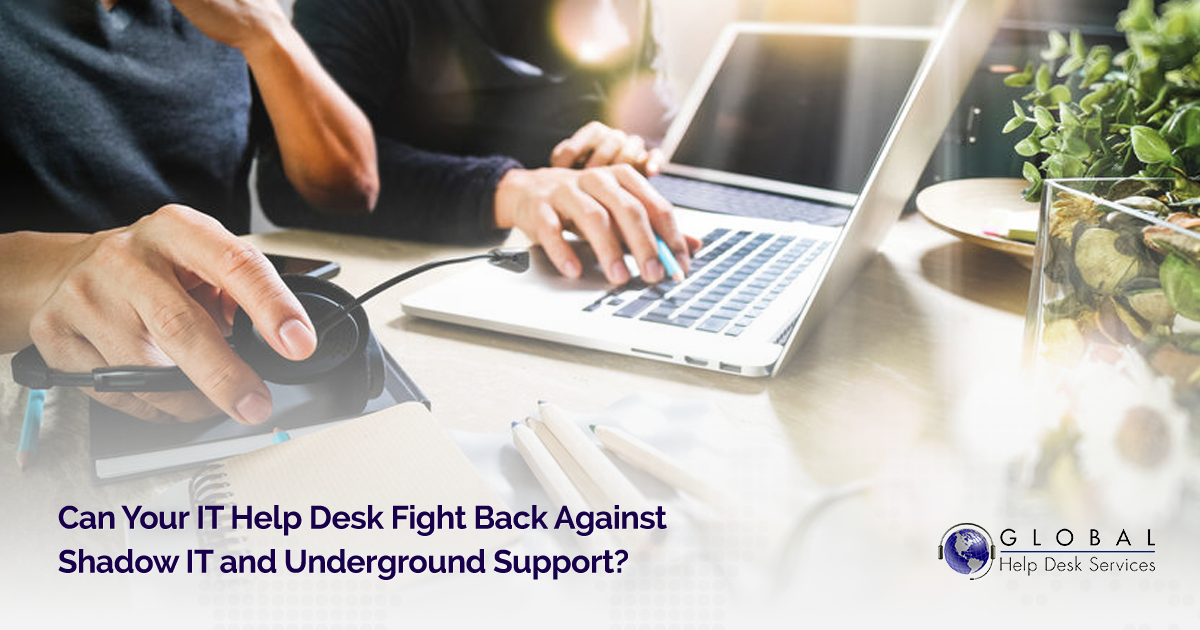Our newly digital world makes it easier than ever for people to find their own answers and their own solutions to their technical problems. This should be a positive, but not when it comes to shadow IT or underground support.
Shadow IT and underground support are two sides of the same coin. Shadow IT happens when internal users (employees, for example) use unauthorized IT such as external chat apps for work-related purposes. Underground support takes place when users seek out IT workarounds from external sources like a friend or online forums.
Either way, users are taking IT matters into their own hands. And that’s causing a lot of problems.
Why Shadow IT and Underground Support Are Dangerous
The immediate issue when dealing with shadow IT and underground support is that it creates a lack of visibility within your organization.
Suddenly, users are recording metrics using unapproved applications or workarounds, using cloud services that don't integrate well with internal services, or experiencing technical issues that your help desk can’t document and report.
As a result, your IT department has no way of accurately assessing and addressing certain issues. Even worse, the individual who used the unauthorized solution might pass that solution on to others with the same issue, exacerbating the problem without the help desk ever knowing about it.
Another major issue with shadow IT and underground support? Compliance. If your company doesn’t have full control over its processes and its data, it could find itself on the wrong side of regulatory legislation.
Speaking of data, if your users are sharing sensitive work data and asking for support recommendations via insecure channels, your cybersecurity risk is much higher than you’d probably like.
Don’t Accept Shadow IT or Underground Support
So, what is the answer?
Underground support and shadow IT remain a challenge for most organizations because individuals need solutions to their problems, and if their organization isn’t providing those solutions, it’s hard to blame them for seeking out other options. This is especially the case if those problems are preventing them from getting their job done.
Does that mean you should embrace shadow IT and underground support, like some people claim?
In our view, the risks largely outweigh any potential benefits.
While there will be isolated incidents of underground support where users find effective, harmless workarounds, it's largely a dangerous practice that you shouldn't accept. Rarely are users qualified to handle technical issues without the support of their help desk. And it’s equally dangerous for users to resort to unauthorized IT solutions and platforms – we understand the need for convenience, but there’s simply too much at stake.
Shadow IT and Underground Support Are a Help Desk Issue
Ultimately, this is a help desk problem. The most effective way to prevent users from seeking underground support is to deliver effective help desk support. And the most effective way to prevent users from using unauthorized IT is to make it as easy as possible for them to use the IT tools that are authorized.
We know, it’s a tall order, especially if you’re working off of antiquated legacy systems that even you hate. But being responsive and sharing the tips and tricks that make these systems work better can make a real difference in end-users’ tolerance and adoption levels.
As it is with most things, communication is vital. First, it’s important to communicate to end users about the dangers of shadow IT and underground support. Sympathize with their need for convenience and speed, explain to them what is at stake, give them information that can help, and then listen to why they’ve explored other options – it’s valuable feedback that can help your entire IT department get a much better handle on end-user needs.
When dealing with underground support specifically, communication is one of the most important things to focus on. Users need to feel satisfied that their help desk is handling their issue in an efficient manner. Do this by following up with users and keeping them in the loop throughout the process.
Here are 3 tips for maintaining communication with your users:
1. Set clear expectations
If a situation is going to take a few hours, days, or even weeks to resolve, the help desk agent needs to communicate this properly. In addition, the agent should explain not only when they’re hoping to fix the problem, but also how they're fixing it.
When users have a clear resolution timeline, they're much more likely to cooperate with the help desk rather than seek out a solution on their own. If they're made aware of how long the issue will persist, they can dedicate that time to another task, rather than wait unproductively for a solution that, for all they know, might never arrive. The last thing you want is to have users sitting around impatiently, wondering when they'll hear back from support. Remember, this is a business issue. Users need to be productive. If something is preventing that, it's understandable that they will go with the first solution that presents itself.
2. Provide frequent updates
Another important reason to maintain communication is to address any delays that might occur throughout the process. Most users will understand that resolution timelines aren’t set in stone thanks to the variables involved in every situation.
What the help desk can do, however, is give the user a firm expectation of when they'll hear back about the issue. Even if there's nothing new to report, staying in contact with the user will decrease the instances of shadow IT. The help desk should implement communication strategies based on the priority of the issue. The more urgent the situation, the more the help desk should be in contact with the user.
3. Offer multiple communication channels
Of course, the effectiveness of your help desk, whether internal or outsourced, doesn't matter if users don't contact it in the first place. There are numerous ways to communicate. The more contact options you offer your users, the more likely they are to find a method that's comfortable for them.
At a minimum, your help desk should offer phone, email, and chat support. There are also secure ways to offer support via SMS messaging. Internal self-service portals and forums remain a popular option because they help users address issues themselves. This eliminates their reliance on external sources while also ensuring that they operate within the company framework, thanks to regular monitoring by an IT staffer who can leap in if misinformation is being shared.
For smaller companies, opening too many support channels might spread your operation too thin, so you'll likely have to choose which channels benefit your company and end users the most. The key principle still stands, though: if a user doesn't want to spend time on the phone, they're not going to call phone support. Offering a variety of options encourages help desk contact and limits cases of underground support.
Shadow IT and Underground Support Are Avoidable – With the Right Team
Shadow IT and underground support lead to serious problems for a company's security and operations. But the remedy is straightforward. It starts with hiring help desk technicians that are good at what they do.
Help desk agents need to be proactive and thorough, ensuring that users can rely on them to help their IT solutions work the way they should. When users get prompt, effective, and truly helpful technical support, they have a lot less reason to look anywhere else.
By the way, underground support is just one of the top ten help desk challenges. Learn all ten and you will put yourself in a position to deliver outstanding help desk support.


